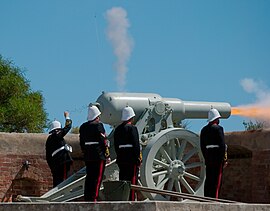Fort Glanville
|
Fort Glanville Conservation Park South Australia |
|
|---|---|

Firing demonstration with one of the fort's RML 64 pounder 64 cwt guns
|
|
| Nearest town or city | Semaphore Park, South Australia |
| Coordinates | 34°51′3.5″S 138°28′37.9″E / 34.850972°S 138.477194°ECoordinates: 34°51′3.5″S 138°28′37.9″E / 34.850972°S 138.477194°E |
| Established | 1951 |
| Area | 5 ha (12 acres) |
| Visitation | 7,000 (in 1988) |
| Managing authorities | Department of Environment, Water and Natural Resources |
| Website | Fort Glanville Conservation Park |
Fort Glanville Conservation Park is a protected area located in the Australian state of South Australia located in Semaphore Park, a seaside suburb of Adelaide consisting of a functional 19th century fort listed on the South Australian Heritage Register and some adjoining land. The fort was built after more than 40 years of indecision over the defence of South Australia. It was the first colonial fortification in the state and is the best preserved and most functional in Australia. Fort Glanville was designed by Governor Major General Sir William Jervois and Lieutenant Colonel Peter Scratchley, both important figures in early Australian colonial defence. When built it was designed to defend both Semaphore's anchorage and shipping entering the Port River from naval attack.
Construction of the fort began in 1878. It was officially opened in October 1880 and completed by 1882. Due to changes in the Port River and shipping movements, Fort Largs surpassed it for strategic importance by 1890. By the close of the 19th century, the fort was largely unused and had no defence significance. It was briefly used for military purposes during World War I and World War II, though not for its original defensive role. For much of the 20th century the area was put to a variety of uses including accommodation, a caravan park and a boy scout campsite. After coming into state government hands in 1951 it was declared as a conservation park and is now managed by the Department of Environment, Water and Natural Resources (DEWNR); preserving and showcasing its historic value. The fort and surrounds occupy the northern half of the 5-hectare (12-acre) conservation park, the southern half is a caravan park. The fort is a lunette shaped defensible battery that was supported by land forces for self-defence. When constructed it was seen as state of the art, incorporating powerful and modern weapons. Its main armament is two rifled muzzle-loading (RML) 10 inch 20 ton guns backed up by two RML 64 pounder 64 cwt guns, both rare in their particular configuration. The fort retains its original 19th century cannons and three have been restored to working condition.
...
Wikipedia

